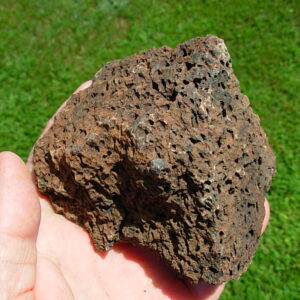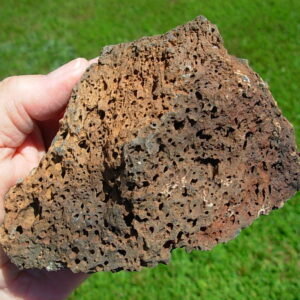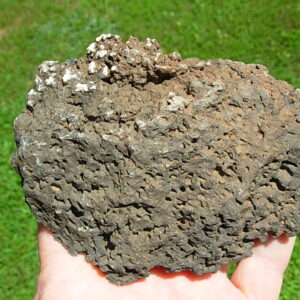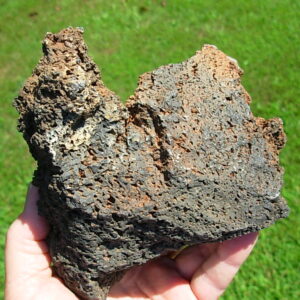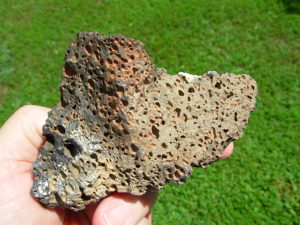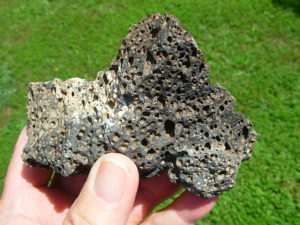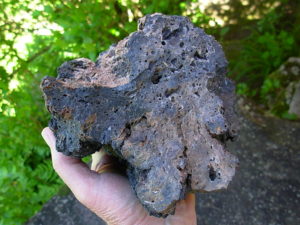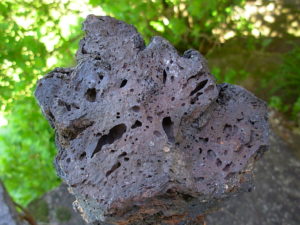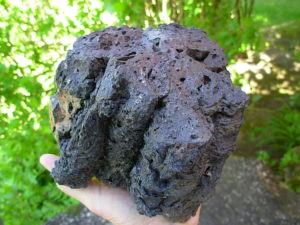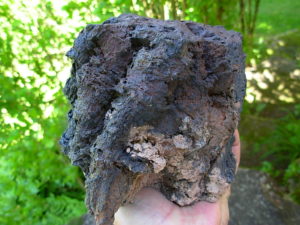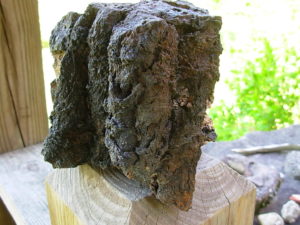Lava Rocks...Volcanic Rocks
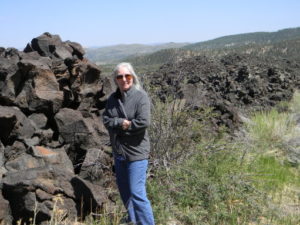 Lava Rocks Volcanic Rocks are terms often used, but is really not correct. Lava is molten or liquid form rock that comes out of a volcano that is erupting. Lava is extremely hot reaching temperatures approaching 2000 degrees. The lava comes out of the volcano and cools on the earths surface depending on how long it takes to cool and becomes different types of igneous rock. These volcanic rocks may be Obsidian or Basalt and other types of igneous rocks. Liquid Rock is not always called Lava. When it is underground it is called magma, when it comes out of the volcano to the earths surface it is called lava. The magma underground is super heated and contains gas bubbles. As these gas bubbles are heated they begin to expand. This expansion causes the magma to be moved up with the expansion. Normally this magma is trapped underground and held there by rock layers above it. If the expansion pressure finds or causes a crack in this rock, the magma can now flow as the gas bubbles expand rapidly. When this occurs we have a volcanic eruption. Lava that is thrown up into the air cools faster and retains more air bubbles and is very light in weight. Lava that "flows and rolls out of the volcano cools slower, allowing the air bubbles to escape the lava flow. The lava flow that crawled along the ground lacks the air bubbles and is much denser and heavier. Here is a volcano description with artwork courtesy of our friends at USGS to help us understand the terminology of volcanic make up. The recent lava flows and cinder cones will be discussed in our descriptions.
Lava Rocks Volcanic Rocks are terms often used, but is really not correct. Lava is molten or liquid form rock that comes out of a volcano that is erupting. Lava is extremely hot reaching temperatures approaching 2000 degrees. The lava comes out of the volcano and cools on the earths surface depending on how long it takes to cool and becomes different types of igneous rock. These volcanic rocks may be Obsidian or Basalt and other types of igneous rocks. Liquid Rock is not always called Lava. When it is underground it is called magma, when it comes out of the volcano to the earths surface it is called lava. The magma underground is super heated and contains gas bubbles. As these gas bubbles are heated they begin to expand. This expansion causes the magma to be moved up with the expansion. Normally this magma is trapped underground and held there by rock layers above it. If the expansion pressure finds or causes a crack in this rock, the magma can now flow as the gas bubbles expand rapidly. When this occurs we have a volcanic eruption. Lava that is thrown up into the air cools faster and retains more air bubbles and is very light in weight. Lava that "flows and rolls out of the volcano cools slower, allowing the air bubbles to escape the lava flow. The lava flow that crawled along the ground lacks the air bubbles and is much denser and heavier. Here is a volcano description with artwork courtesy of our friends at USGS to help us understand the terminology of volcanic make up. The recent lava flows and cinder cones will be discussed in our descriptions.

Volcanic Rocks and Associated Landforms
Examples of landform features associated with modern and ancient volcanism. A volcano forms at an site where erupted material builds up (including lava flows, cinders, and ash). Over time, weathering and erosion break down and strip away surficial materials, leaving behind remnants of volcanic rock that chilled below the surface (including plutons, dikes, sills, and laccoliths). A pluton is a deep-seated igneous intrusion. A stock is a remnant of the vent of a volcano or plutonic body with an areal extent less than 40 square miles (or 100 square kilometers). Far below the surface, a large magma chamber will slowly cool to form small plutons and large batholiths. A dike is a place were molten material cooled in a vertical crack. Sills form when molten material squeezes between horizontal layers. An escarpment that forms when erosion exposes a sill is call a palisade. A laccolith is a blister-shaped intrusion.
USGS Western Region Geology and Geophysics Science Center
The URL is http://pubs.usgs.gov/of/2004/1007/volcanic.html
Page Contact Information: USGS Publications Team
While on our rock finding trip to Utah in 2012 we went to the Cedar Breaks (elevation 10,350 ft) and the surrounding areas from Navajo Lake, Panguitch Lake and Duck Creek Village. We realized we were driving past massive cinder cones and lava flows. We stopped, picked up some specimens and later researched this geologic event with the following results...We were at the Markagunt Plateau Volcanic field.
The Markagunt Plateau volcanic field, located east of Cedar Breaks National Monument in SW Utah, is a group of cinder cones and lava vents on Markagunt Plateau. The youngest cinder cones are located near Panguitch Lake in the north and Navajo Lake in the south. The elevation is 9,000 to 10,000 ft above sea level.
Volcanic activity on the eastern Markagunt Plateau began about 5 million years ago and has been continuing up to the last eruption, which occurred only about 1,000 years ago. The date was obtained by dendrochronology, i.e. by counting the growth rings and thus, the age, of the oldest trees on the flow. A common maximum age of 900 years for the oldest present trees (big gnarled junipers (/. scapularium)) was found, which suggests the age of the flow being only about 1000 years old, if the first trees appeared to grow 100 years after the flow was emplaced.
Background:
Eruptions in the Markagunt Plateau field have produced basaltic flows at Miller Knoll, Cooper Knoll, and Henry Peaks, Duck Creek, at Bowers Flat, in Black Rock and in the upper Rock Creek valleys.
The oldest episodes of volcanic activity produced silica-rich trachytic, andesitic and rhyolitic lavas, and were followed by extensive basaltic lavas occuring in 2 different ages. Several lines of NE-SW-trending cinder cones occur within the volcanic field. The most recent cinder cones were formed near Panguitch Lake in the north and Navajo Lake in the south. Navajo Lake formed when a thick, blocky flow from a nearby vent dammed Duck Creek. Young lava flows, many of which are fissure fed, have distinct margins and covered or diverted stream drainages, which have for the most part not been reestablished across the flows.
Specimens listed here are natural as they were found. They were only rinsed off with pure water to remove the loose dust and dirt. The coloration is exactly how we found these pieces. Photos taken in natural sunlight with the volcanic rock dry.
Item# L1
Markagunt Plateau Volcanic Rock
$9.65

This piece weighs 11.3oz or 0.7 lbs (321g) and measures 4.7 x 2.8 x 2.5 inches (11.9 x 7.2 x 6.5cm)
Item# 28
Large Markagunt Plateau Volcanic "Rope"Rock
$42.00

This piece weighs 101.9oz or 6.37 lbs (2.89kg) and measures 6 x 5 x 4.7 inches (15.4 x 12.7 x 12cm)


